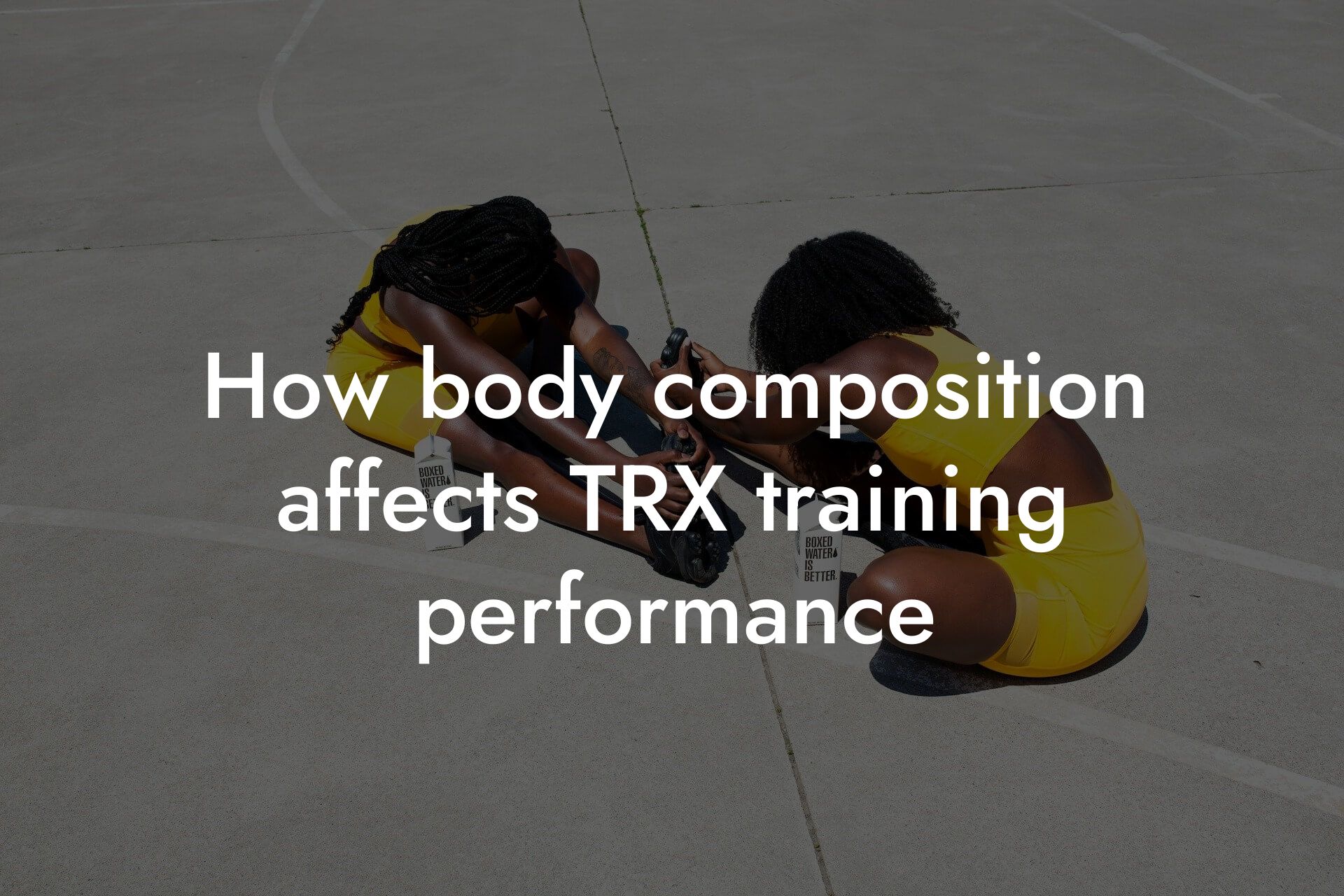As a high-earning professional, you understand the importance of maintaining a healthy and fit physique. Not only does it boost your confidence, but it also enhances your overall well-being and productivity. If you're incorporating TRX workouts into your fitness routine, reducing body fat is crucial to achieve optimal results. In this article, we'll delve into the importance of reducing body fat, the benefits of TRX workouts, and provide you with a comprehensive guide on how to reduce body fat for better TRX workout results.
Table of Contents
Why Reducing Body Fat is Crucial for TRX Workouts
TRX workouts are a form of suspension training that targets multiple muscle groups simultaneously. While it's an effective way to build strength and endurance, it's essential to have a low body fat percentage to reap the full benefits. Excess body fat can hinder your progress, making it challenging to achieve the desired results. By reducing body fat, you'll be able to:
• Increase muscle definition and visibility
• Enhance overall athletic performance
• Improve joint mobility and reduce the risk of injury
• Boost metabolism and burn more calories at rest
Understanding Body Fat Percentage
Before we dive into the strategies for reducing body fat, it's essential to understand what body fat percentage is and how it's measured. Body fat percentage is the proportion of fat to lean mass in your body. The American Council on Exercise (ACE) categorizes body fat percentage into the following ranges:
• Athlete: 6-13% (men), 16-23% (women)
• Fitness: 14-17% (men), 24-27% (women)
• Average: 18-21% (men), 28-31% (women)
• Obese: 22% or higher (men), 32% or higher (women)
At Tano Performance Group, we use DEXA machine technology to provide accurate body fat percentage measurements. This advanced technology helps you track your progress and make data-driven decisions to achieve your fitness goals.
Creating a Calorie Deficit
Reducing body fat requires a calorie deficit, which means consuming fewer calories than your body burns. This can be achieved through a combination of diet and exercise. To create a calorie deficit, focus on:
• Eating nutrient-dense foods, such as lean proteins, whole grains, and vegetables
• Reducing portion sizes and avoiding overeating
• Incorporating high-intensity interval training (HIIT) and strength training exercises
• Increasing your daily physical activity levels
Macronutrient Balance
A well-balanced diet is crucial for reducing body fat. Focus on the following macronutrient ratios:
• Protein: 1.6-2.2 grams per kilogram of body weight
• Carbohydrates: 2-3 grams per kilogram of body weight
• Fat: 0.5-1 gram per kilogram of body weight
Make sure to consume protein-rich foods, such as lean meats, fish, and eggs, to support muscle growth and repair. Complex carbohydrates, like whole grains and vegetables, provide energy for your workouts. Healthy fats, like avocado and nuts, support hormone production and overall health.
Incorporating TRX Workouts
TRX workouts are an excellent way to build strength, endurance, and flexibility. To incorporate TRX into your fitness routine, focus on:
• Starting with 2-3 TRX sessions per week and gradually increasing frequency
• Incorporating a mix of upper body, lower body, and core exercises
• Using progressive overload techniques, such as increasing reps or sets, to challenge your muscles
• Focusing on proper form and technique to avoid injury
Progressive Overload and Periodization
To continue making progress and reducing body fat, it's essential to incorporate progressive overload and periodization into your TRX workouts. Progressive overload involves gradually increasing the intensity of your workouts by:
• Adding weight or resistance
• Increasing reps or sets
• Decreasing rest time between exercises
Periodization involves dividing your workout routine into specific phases, each with a unique goal. For example, you may focus on building strength during one phase and endurance during another. This helps to avoid plateaus and promotes continued progress.
Staying Hydrated and Getting Enough Sleep
Proper hydration and sleep are crucial for reducing body fat and achieving optimal TRX workout results. Make sure to:
• Drink at least 8-10 glasses of water per day
• Aim for 7-9 hours of sleep per night
• Establish a consistent sleep schedule to regulate your hormones and metabolism
Tracking Progress and Staying Motivated
Tracking your progress and staying motivated are essential for reducing body fat and achieving your fitness goals. Use the following strategies to stay on track:
• Take progress photos and measurements regularly
• Track your workouts and nutrition using a journal or mobile app
• Set realistic goals and celebrate your achievements
• Find a workout buddy or join a fitness community for support and accountability
By following these strategies and incorporating TRX workouts into your fitness routine, you'll be able to reduce body fat and achieve optimal results. Remember to stay patient, consistent, and motivated, and you'll be on your way to a leaner, stronger, and healthier physique.
Frequently Asked Questions
What is the ideal body fat percentage for optimal TRX workout results?
For men, an ideal body fat percentage for optimal TRX workout results is between 8-14%, while for women, it's between 16-23%. However, this can vary depending on individual goals and fitness levels. Having a healthy body fat percentage can improve overall athletic performance, increase strength, and enhance endurance.
How does excess body fat affect my TRX workout performance?
Excess body fat can hinder your TRX workout performance by reducing your power, speed, and agility. It can also increase your risk of injury, as excess weight can put additional stress on your joints. Furthermore, excess body fat can make it more challenging to maintain proper form and technique during exercises, which can lead to poor results and frustration.
What are the benefits of reducing body fat for TRX workouts?
Reducing body fat can improve your overall athletic performance, increase your strength-to-weight ratio, and enhance your endurance. It can also boost your confidence, reduce your risk of injury, and improve your overall health and well-being. Additionally, reducing body fat can help you achieve a more toned and lean physique, which can be motivating and rewarding.
How do I measure my body fat percentage?
There are several ways to measure body fat percentage, including skinfold measurements, bioelectrical impedance analysis (BIA), dual-energy X-ray absorptiometry (DXA), and hydrostatic weighing. You can also use a body fat caliper to measure your skinfold thickness at specific points on your body. It's essential to work with a qualified professional to ensure accurate measurements.
What is the best way to reduce body fat for TRX workouts?
A combination of a healthy diet, regular cardio exercise, and strength training is the most effective way to reduce body fat for TRX workouts. Focus on consuming a balanced diet that is high in protein, moderate in complex carbohydrates, and low in processed foods and added sugars. Aim to perform at least 150 minutes of moderate-intensity cardio exercise per week, and incorporate strength training exercises that target all major muscle groups.
How long does it take to notice results from reducing body fat?
The time it takes to notice results from reducing body fat can vary depending on individual factors, such as starting body fat percentage, diet, exercise routine, and overall health. However, with consistent effort and a well-structured plan, you can start to notice improvements in your body composition and TRX workout performance within 6-12 weeks.
What are some common mistakes people make when trying to reduce body fat?
Common mistakes people make when trying to reduce body fat include crash dieting, overexercising, and neglecting proper nutrition. Crash dieting can lead to muscle loss and a slower metabolism, while overexercising can cause burnout and injury. Neglecting proper nutrition can make it challenging to support muscle growth and recovery. It's essential to focus on sustainable lifestyle changes that promote overall health and well-being.
How does nutrition play a role in reducing body fat for TRX workouts?
Nutrition plays a critical role in reducing body fat for TRX workouts. A well-balanced diet that is high in protein, moderate in complex carbohydrates, and low in processed foods and added sugars can help support muscle growth and recovery. Additionally, adequate hydration and healthy fats are essential for optimal performance and body composition.
What are some healthy meal options for reducing body fat?
Healthy meal options for reducing body fat include lean protein sources like chicken, fish, and turkey, complex carbohydrates like brown rice, quinoa, and sweet potatoes, and healthy fats like avocado, nuts, and seeds. Aim to include a variety of colorful vegetables in your meals, and limit your intake of processed foods and added sugars.
How can I stay motivated to reduce body fat and improve my TRX workout results?
Staying motivated to reduce body fat and improve your TRX workout results requires setting specific, measurable, and achievable goals. Celebrate your progress, no matter how small, and focus on the process rather than the outcome. Find a workout buddy or join a fitness community to provide accountability and support. Reward yourself for milestones achieved, and don't be too hard on yourself when you encounter setbacks.
What role does sleep play in reducing body fat and improving TRX workout results?
Sleep plays a critical role in reducing body fat and improving TRX workout results. During sleep, your body repairs and rebuilds muscle tissue, regulates hormones, and consolidates memories. Aim for 7-9 hours of sleep per night to support optimal recovery and performance.
How can I incorporate strength training into my TRX workout routine?
Incorporating strength training into your TRX workout routine can be achieved by adding exercises that target all major muscle groups, such as squats, lunges, push-ups, and rows. Aim to perform strength training exercises 2-3 times per week, and focus on progressive overload to continue challenging your muscles.
What are some common myths about reducing body fat and improving TRX workout results?
Common myths about reducing body fat and improving TRX workout results include the idea that low-intensity cardio is the most effective way to burn fat, that you need to spend hours in the gym to see results, and that you can spot reduce body fat. These myths can be misleading and may hinder your progress. Focus on evidence-based information and consult with a qualified professional to develop a personalized plan.
How can I track my progress and stay accountable?
Tracking your progress and staying accountable can be achieved by taking progress photos, measurements, and body fat percentage readings. You can also use a food diary or mobile app to track your nutrition and exercise habits. Share your goals and progress with a friend or workout buddy to provide accountability and support.
What are some common challenges people face when trying to reduce body fat and improve TRX workout results?
Common challenges people face when trying to reduce body fat and improve TRX workout results include lack of motivation, inconsistent nutrition and exercise habits, and unrealistic expectations. Additionally, people may struggle with self-doubt, plateaus, and setbacks. It's essential to focus on progress, not perfection, and to be patient and compassionate with yourself throughout your journey.
How can I overcome plateaus and continue making progress?
Overcoming plateaus and continuing to make progress requires reassessing your nutrition and exercise habits. Try adjusting your macronutrient ratios, increasing your intensity or volume, or incorporating new exercises and movements. It's also essential to listen to your body and take rest days as needed to avoid burnout and injury.
What role does stress play in reducing body fat and improving TRX workout results?
Stress can play a significant role in reducing body fat and improving TRX workout results. Chronic stress can lead to increased cortisol levels, which can promote belly fat storage and hinder muscle growth. Engage in stress-reducing activities like yoga, meditation, or deep breathing exercises to help manage stress and support overall health and well-being.
How can I incorporate TRX exercises into my workout routine?
Incorporating TRX exercises into your workout routine can be achieved by starting with beginner-friendly exercises like rows, bicep curls, and tricep dips. Gradually increase the intensity and difficulty as you become more comfortable with the movements. Aim to perform TRX exercises 2-3 times per week, and focus on progressive overload to continue challenging your muscles.
What are some common mistakes people make when performing TRX exercises?
Common mistakes people make when performing TRX exercises include poor form, inadequate warm-up, and overexercising. It's essential to focus on proper form and technique, warm up thoroughly before each workout, and listen to your body to avoid injury.
How can I modify TRX exercises to suit my fitness level?
Modifying TRX exercises to suit your fitness level can be achieved by adjusting the angle of your body, reducing the intensity, or using assistance from a partner or resistance band. It's essential to focus on proper form and technique, and to listen to your body to avoid injury.
What are some benefits of incorporating TRX exercises into my workout routine?
Incorporating TRX exercises into your workout routine can improve your overall strength, flexibility, and balance. It can also enhance your core stability, boost your metabolism, and increase your functional fitness. Additionally, TRX exercises can be modified to suit different fitness levels, making it an accessible and effective way to improve your overall fitness.
Here are some related articles you might love...
- Improving core strength with TRX training
- Using DEXA scans to monitor progress in TRX training
- How body composition affects TRX training performance
- Balancing strength and flexibility in TRX workouts
- The importance of bone density in TRX fitness
- Strength training tips specific to TRX exercises
- Nutrition tips for sustained energy during TRX sessions
- Maintaining muscle recovery with TRX training
- Preventing injuries during TRX training
Zak Faulkner
Zak Faulkner is a leading authority in the realm of physical health and body composition analysis, with over 15 years of experience helping professionals optimise their fitness and well-being. As one the experts behind Tano Performance Group, Zak has dedicated his career to providing in-depth, science-backed insights that empower clients to elevate their physical performance and overall health.
With extensive knowledge of DEXA technology, Zak specializes in delivering comprehensive body assessments that offer precise data on body fat, muscle mass, bone density, and overall physique. His expertise enables individuals to make informed decisions and achieve their fitness goals with accuracy and confidence. Zak’s approach is rooted in a deep understanding of human physiology, combined with a passion for helping clients unlock their full potential through personalised strategies.
Over the years, Zak has earned a reputation for his commitment to excellence, precision, and client-focused service. His guidance is trusted by top professionals who demand the best when it comes to their health. Whether advising on fitness programs, nutritional strategies, or long-term wellness plans, Zak Faulkner’s insights are a valuable resource for anyone serious about taking their health and fitness to the next level.
At Tano Performance Group, Zak continues to lead our Content Team revolutionising how professionals approach their physical health, offering unparalleled expertise that drives real results.




